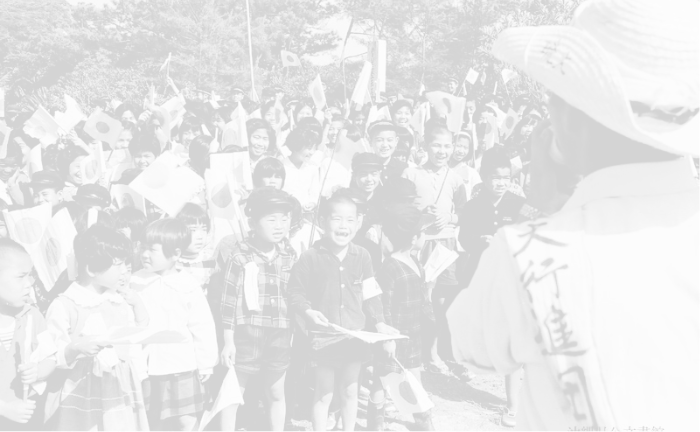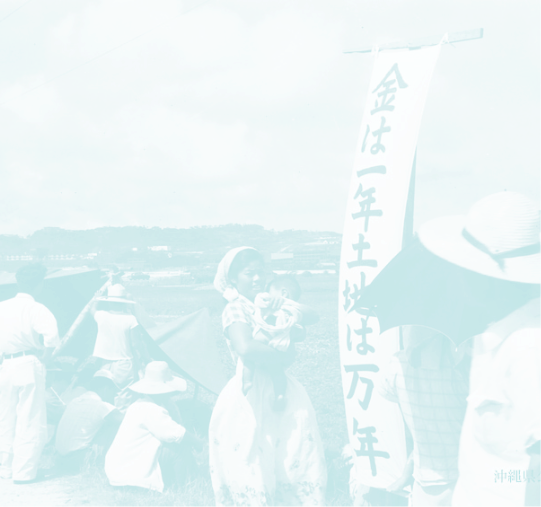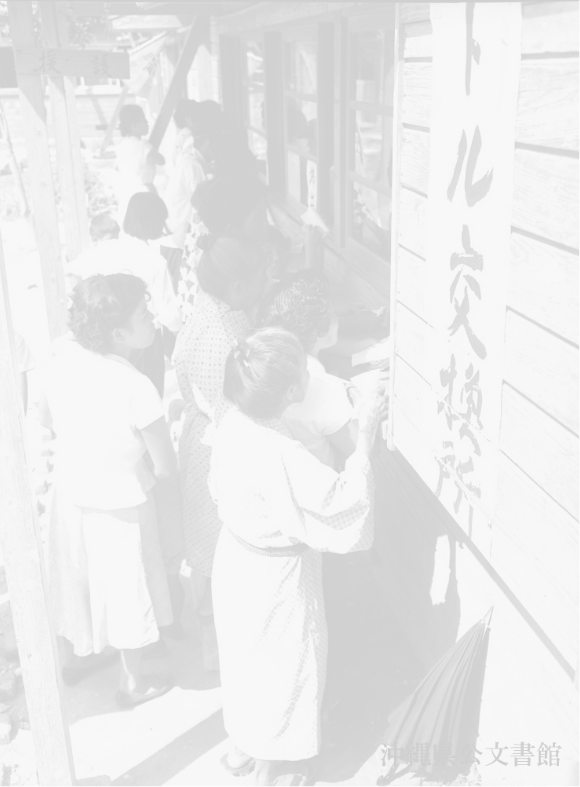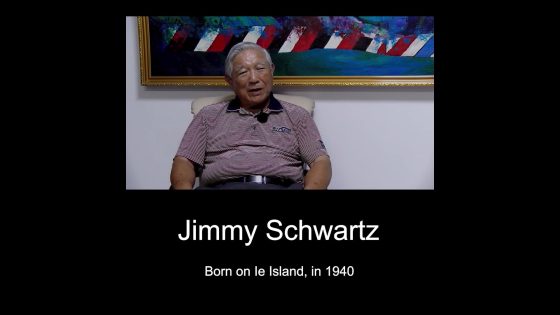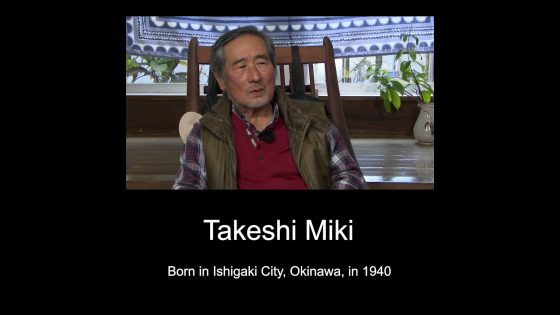
After the War: Living in Ishikawa
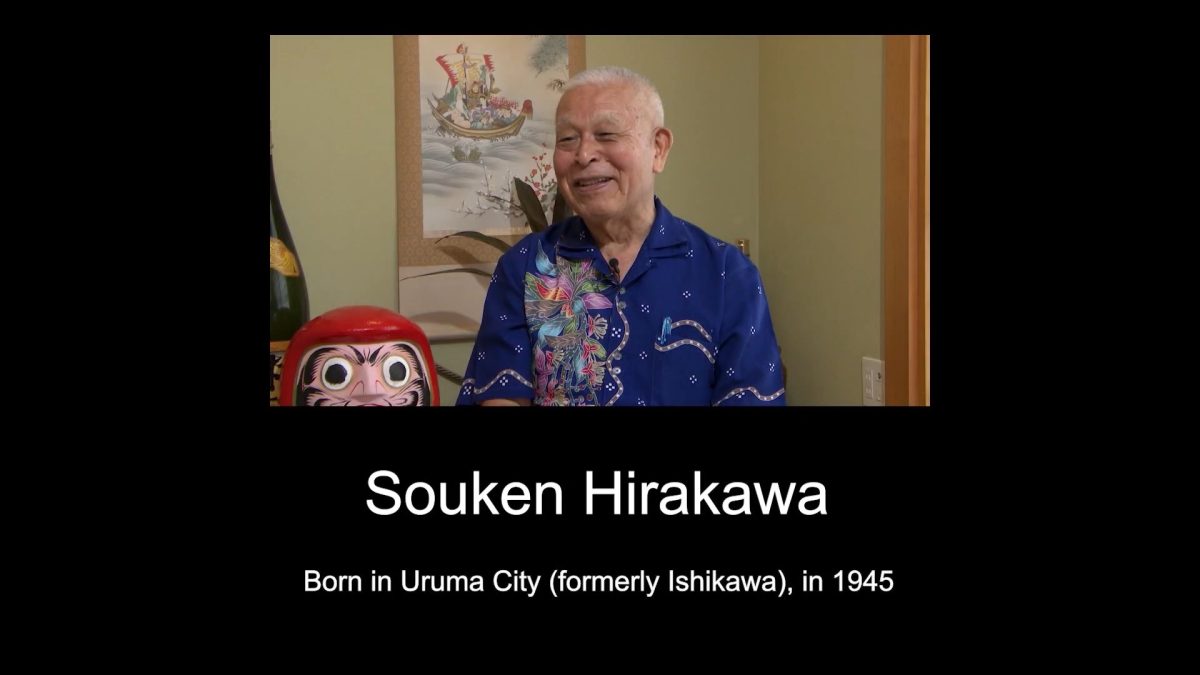

- Born in 1945
- Souken Hirakawa
Timeline
| 1945 |
Born in a prison camp on Saipan.
|
|
|---|---|---|
| 1955 |
The "Yumiko-chan incident" occurred, in which a young girl from Ishikawa City was killed.
|
|
| 1959 |
On June 30, a U.S. military jet crashed into Miyamori Elementary School.
|
|
| 1964 |
After graduating from Ryukyu Government Technical High School, he continued his studies in electricity at a technical college in Tokyo.
|
|
| 1970 |
On December 20, he witnessed the scene of the Koza Riots.
|
|
| 1971 |
Founded Hinode Electric in his hometown of Ishikawa (now Uruma City).
|
|
| 1972 |
On May 15, Okinawa's administrative rights were returned to Japan. (Reversion of Okinawa)
|
|
| 1990 |
Became a member of the Ishikawa City Council. (three terms: until 2002)
|
|
| 1992 |
Elected mayor of Ishikawa and served as mayor. (until the merger in 2005)
|
|
| 2005 |
Uruma City was formed by the merger of two cities and two towns. (April 1)
|
Story
Brief biography of the witness
Spent his childhood in the Higashionna district of Ishikawa City (now Uruma City), and while running an electronics store, he served as a member of the Ishikawa City Council and president of the Ishikawa Junior Chamber of Commerce before serving as mayor of Ishikawa. He has continued to observe the postwar situation of Ishikawa City, the lives of the people in the area of the U.S. military base, and the transition of the city, and has devoted himself to various activities in the community. He also witnessed the U.S. military plane crash at Miyamori Elementary School and the Koza riots.。
Postwar Ishikawa and People's Lives
Postwar Ishikawa and the Bustling Market
Ishikawa was a very lively city. I remember getting lost in a market in Ishikawa when I entered elementary school. My mother and I used to go to Ishikawa to shop during Obon [mid August] and New Year holidays. One time, I got separated from my mother. The market was so busy that people were push and shove each other, which is unimaginable today.
The School Learning Environment
The kindergarten had a corrugated iron roof and the windows were left open to let in the air. When it rained, water would come in onto the dirt floor. When I was in the second grade of elementary school, our school building, a Quonset hut, was sold to the US military, I think. When it rained, water would come in, so I had to put my feet up to keep them dry. I think my sister, who is two years younger than me, was in about 10 classes. She was from the baby boom generation. I was born in 1945. There were about 10 baby boom classes for kids born in 1947, 1948, and 1949.
Life in the Areas Where US Military Bases Were Located
I think this area was also a US military base. It was called the African-American corps. At that time, there was Ishikawa Beach in the Ishikawa district, so people generally thought of it like a resort. I also remember that there was a missile base in the mountains of the Mihara district. In Higashionna district, there was a US military base behind where San-A’s Higashionna store is now, and around that time in the evening, I don't know if it was a training exercise, but I remember the sight of the missile appearing. The launch pad would open, a missile would came out, but it wouldn’t launch. For those in the Sonan region, when we went to the river and passed through Yamashiro, there was a base to our left. There was an Okinawan US military guard standing there. I often saw American soldiers firing live ammunition from near the base. I would watch from the Yamashiro entrance. Of course, I couldn't enter Sonan because it was a US military base.
When we were children, we went to the Ishikawa area from junior high school onwards, but when we were in elementary school, there was a US military baseball field nearby. The older kids used to play baseball there with the American soldiers. We were able to get into that area, so I remember watching a lot of baseball games. If we said “Give me chocolate” to an American, we would receive something. Even if we didn't understand English, most children understand the meaning. If we said “Give me chocolate” or “Give me,” we might get something from an American. Prefectural Route 6 in this area used to be called the military road.US military tanks often passed by that area, and US soldiers would march. There were no sidewalks yet, so American soldiers used to take breaks inside the village. That's when I would tell them, “Give me chocolate.” Rather than being scared of American soldiers, I thought they might give me something.
The US military conducted exercises around bases and in civilian areas. I myself never scavenged for their leftover food, but umaku [misbehaving people] would scavenge for food and eat it. For the US military, there was something called a Ration Set. It contained things like coffee and milk crackers. Many umakus would steal them or find them, and boasted about their “military achievements.” Stealing from the US military was bad though. Back then, they said it like heroes. So did adults back then. I have such memories, like when I was in elementary school.
Unexploded Ordnance in the Neighborhood
The teacher actually held a grenade and showed it to us, saying, “If you see one of these, don't touch it. Tell a teacher immediately,” at the morning assembly. At the time, there was no gymnasium, so the morning assembly was held outside. In fact, I believe that the grenade was passed around to the students, and of course, it did not contain any explosive. I received such warnings several times. And at that time, some people would actually be injured by grenades. Grenades were also used to catch fish in the sea. There were also stories of people who lost their hands in explosions. My wife told me that someone threw a grenade into the sea, and her brother survived by diving into the sea, but the person by his side died. There were accidents like that. And the other thing was, there was a small mountain near the school that was full of gunpowder. There was a lot of gunpowder, and the older kids collected it and packed it into 3.6- liter cans. They’d sprinkle gunpowder on the ground and light it with a match, and you’d hear a sound. Everyone expected it to explode, but it didn't. We played games like that. Actually, we would just watch. At that time, there was a lot of gunpowder in familiar places. That, and human bones. There were quite a few human bones in places like gama [natural caves]. I don't think they was human bones from old graves.
US Military Plane Crash at Miyamori Elementary School
Witnessing a US Military Plane Crash at Miyamori Elementary School
I was in junior high school at the time. It was my second year, and it was just PE time. There was no gymnasium, so I would change clothes at the playground. Many people saw US military aircraft. I was just changing clothes after PE and was changing from my gym clothes to my uniform. One day, I saw a US military plane on fire. The jet was engulfed in fire, obviously not normal. A moment later, I heard a bang and saw a pillar of fire. We thought it hit the second floor of the school building. Everyone ran towards it, but it had crashed at Miyamori Elementary School. So we saw the aftermath of the crash. I was so shocked seeing the blackened body that I couldn't tell if it was a man or a woman, and I couldn't do anything.
People's Lives around US Military Bases
US Military Bases and People’s Lives
After the war, there were no companies where people could work. That's why many people worked at US military bases, and their jobs included carpentry and working at parking lots [military vehicle depots].When we were kids, we worked at parking lots or as carpenters, or as housekeepers. My aunt was hired by the US military and sometimes went out to mow grass even though she was as old as she was. My older sister would also go mow grass. This was a good income.
The other thing was that Americans might rent a part of a house, which was the case with our house. Our house was already old and small, but we only used the kitchen and a small space, and rented out the nice rooms to Americans. Perhaps the Americans had local wives. Those kinds of things happened everywhere. That's probably how they got their rent. There were houses everywhere that rented out rooms to Americans. Women who dated Americans would be called “Honey.” When I saw couples, I would say, “Honey-guwa.”
Getting American Products
People who worked for American families as housekeepers often received sweets. When Americans at the US military base in Okinawa finished their duty, they all went to their next transfer station or to their hometowns, leaving behind clothes, dishes, food, etc. We called it “going home” with the English words. They gave them to housekeepers. We do the same thing when we move, right? The most valuable item was the television. The first time I watched television was when a relative of mine worked for an American family, and his employer gave him a television when he “went home.” We all gathered at the relative's house and watched TV. Okinawa TV had not yet started broadcasting. At that time, the only broadcast was by the US military. Back then, we had black and white TVs, but they were still very rare. That's what I remember. That was back when I saw a television for the first time.
People Working at US Military Bases
Many of my older classmates worked as staff members, bartenders, cooks, and other jobson the base. In America, when someone's achievements are recognized, something would be named after that person. Kudaka House is good example. Mr. Hisataka, who has already passed away, was a cook at Kadena Air Base, so the officer's club was named Kudaka House. I was lucky enough to be invited there, when I was the mayor. I think it was the Kadena ceremony. And street names, too. On Iejima Island, there is a street called Jimmy Street, named after an American adoptee named Jimmy. In the US, it seems like things are named after people who have left a legacy, such as Kennedy Street and Kennedy Airport.
People’s Lives around the Bases
At that time, there was the African-American corps, and the soldiers used to get drunk and come out into the streets at night. They were young, and they were looking for women, perhaps because they thought of themselves as occupiers. For this reason, the neighborhood association organized a vigilante group centered around the youth association, to protect women.The neighborhood president told us not to get involved with foreign soldiers, since we could be taken by the MPs [American Military Police] and get in trouble. The youth group's vigilante group patrolled every day.
My family ran a laundry shop for the US military when my father was in good health. He handled US military uniforms. There were no electric irons yet, so we used charcoal irons. At one point, some clothes got stolen and we had to pay for them. I rented someone's house and ran a business in front of the gate of a US military base. I did business with the US military. Food-related businesses were different from those for the general public, but we had an A-SIGN. That was in the downtown area of Ishikawa, and I don't think there was an A-SIGN around here.
The Presence of the US Military in Daily Life
The US military bases have been there since I was little, so I never really felt like they were anything special. It was common for American soldiers to march and tanks to pass bit he tanks would pass by, leaving tracks from their treads on the military road. Nowadays, people transport things like excavators on trailers. Back then, big tanks and US military vehicles would just drive by. All roads, including national highways, were used the same way.
Behind the Koza Riot
Incidents and Accidents Related to the US Military, Koza Riot
There were frequently accidents and murders related to the US military. There were taxi driver attacks, and people being shot by Americans on the bases. There was also the Yumiko-chan Incident in 1955. Even if an incident or accident occurred, things like the details of the trial were not known. Once the defendant returned to the US, the details were completely lost. I think there was always a lot of resentment in the hearts of the Okinawan people. However, there were many people working on bases and working with the US military. That's why I think the Koza Riots occurred in 1970.At the time, I was also nearby, drinking in Nakanomachi in Koza. If I’d been sober instead of drunk, I might have participated. That day, I was drinking with a friend in Koza, getting drunk, and was about to leave when I saw an American being chased and running away. When I came out to Gate Street, a car was on fire. At the time, I didn't realize it was a car and thought it was a festival torch being lithic was wondering if there was a festival. The next day, I read the newspaper and learned that it was the Koza Riots.
The Symbol of the Return Movement
Okinawa’s return to Japan was a big milestone, but it also just made sense. At that time, I was busy with work and left all the PTA activities to my wife, but before Okinawa’s return to Japan, when we were children, we used to sell Japanese flags at school. The symbol of the return movement was the Japanese flag. At school, all students did the school dance, holding the Japanese flag. Times changed, and before I knew it, there was a movement against the Japanese flag, which came as a surprise to me. After Okinawa was returned to Japan, I served as a PTA officer. During the entrance ceremony, there was a movement by some teachers to prevent the raising of the Japanese flag. I felt conflicted about the difference in how we perceived the Japanese flag, and I thought, “How did this happen?” I realized that in the end, it is people who use the Japanese flag. During the war, of course, people marched with the Japanese flag raised.
